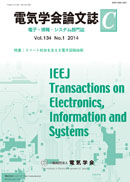Volume 134, Issue 12
Displaying 1-28 of 28 articles from this issue
- |<
- <
- 1
- >
- >|
Special Issue on “2013 Tokai-Section Joint Convention of Institutes of Electrical Engineering”
Preface
-
2014Volume 134Issue 12 Pages 1766
Published: 2014
Released on J-STAGE: December 01, 2014
Download PDF (177K)
Special Issue Paper
<Electrical and Electronic Circuit, LSI>
-
2014Volume 134Issue 12 Pages 1767-1774
Published: 2014
Released on J-STAGE: December 01, 2014
Download PDF (725K) -
2014Volume 134Issue 12 Pages 1775-1782
Published: 2014
Released on J-STAGE: December 01, 2014
Download PDF (1995K)
<Systems, Instrument, Control>
-
2014Volume 134Issue 12 Pages 1783-1795
Published: 2014
Released on J-STAGE: December 01, 2014
Download PDF (1882K) -
2014Volume 134Issue 12 Pages 1796-1801
Published: 2014
Released on J-STAGE: December 01, 2014
Download PDF (601K) -
2014Volume 134Issue 12 Pages 1802-1808
Published: 2014
Released on J-STAGE: December 01, 2014
Download PDF (832K)
<Speech and Image Processing, Recognition>
-
2014Volume 134Issue 12 Pages 1809-1816
Published: 2014
Released on J-STAGE: December 01, 2014
Download PDF (2548K) -
2014Volume 134Issue 12 Pages 1817-1823
Published: 2014
Released on J-STAGE: December 01, 2014
Download PDF (2012K) -
2014Volume 134Issue 12 Pages 1824-1831
Published: 2014
Released on J-STAGE: December 01, 2014
Download PDF (1986K)
Special Issue Letter
<Intelligence, Robotics>
-
2014Volume 134Issue 12 Pages 1832-1833
Published: 2014
Released on J-STAGE: December 01, 2014
Download PDF (811K)
Paper
<Electronic Materials and Devices>
-
2014Volume 134Issue 12 Pages 1834-1839
Published: 2014
Released on J-STAGE: December 01, 2014
Download PDF (1234K)
<Information and Communication Technology>
-
2014Volume 134Issue 12 Pages 1840-1846
Published: 2014
Released on J-STAGE: December 01, 2014
Download PDF (1304K)
<Biomedical Engineering>
-
2014Volume 134Issue 12 Pages 1847-1854
Published: 2014
Released on J-STAGE: December 01, 2014
Download PDF (1390K)
<Systems, Instrument, Control>
-
2014Volume 134Issue 12 Pages 1855-1861
Published: 2014
Released on J-STAGE: December 01, 2014
Download PDF (960K) -
2014Volume 134Issue 12 Pages 1862-1868
Published: 2014
Released on J-STAGE: December 01, 2014
Download PDF (2149K) -
2014Volume 134Issue 12 Pages 1869-1874
Published: 2014
Released on J-STAGE: December 01, 2014
Download PDF (759K)
<Intelligence, Robotics>
-
2014Volume 134Issue 12 Pages 1875-1881
Published: 2014
Released on J-STAGE: December 01, 2014
Download PDF (734K)
<Speech and Image Processing, Recognition>
-
2014Volume 134Issue 12 Pages 1882-1887
Published: 2014
Released on J-STAGE: December 01, 2014
Download PDF (729K) -
2014Volume 134Issue 12 Pages 1888-1896
Published: 2014
Released on J-STAGE: December 01, 2014
Download PDF (1294K)
<Information System, Electronic Commerce>
-
2014Volume 134Issue 12 Pages 1897-1907
Published: 2014
Released on J-STAGE: December 01, 2014
Download PDF (1231K)
<Information Processing, Software>
-
2014Volume 134Issue 12 Pages 1908-1915
Published: 2014
Released on J-STAGE: December 01, 2014
Download PDF (1122K) -
2014Volume 134Issue 12 Pages 1916-1924
Published: 2014
Released on J-STAGE: December 01, 2014
Download PDF (1273K)
<Energy, Environment and Sustainability>
-
2014Volume 134Issue 12 Pages 1925-1933
Published: 2014
Released on J-STAGE: December 01, 2014
Download PDF (1608K)
Letter
<Electronic Materials and Devices>
-
2014Volume 134Issue 12 Pages 1934-1935
Published: 2014
Released on J-STAGE: December 01, 2014
Download PDF (336K)
<Speech and Image Processing, Recognition>
-
2014Volume 134Issue 12 Pages 1936-1937
Published: 2014
Released on J-STAGE: December 01, 2014
Download PDF (2720K)
-
2014Volume 134Issue 12 Pages ES12_1-ES12_2
Published: 2014
Released on J-STAGE: December 01, 2014
Download PDF (284K)
-
2014Volume 134Issue 12 Pages NL12_1-NL12_3
Published: 2014
Released on J-STAGE: December 01, 2014
Download PDF (261K)
-
2014Volume 134Issue 12 Pages L12_1
Published: 2014
Released on J-STAGE: December 01, 2014
Download PDF (78K)
- |<
- <
- 1
- >
- >|
